#variance analysis
Explore tagged Tumblr posts
Text
Do you know Financial Analysis Essential Tools? Let's Decode
Introduction Financial analysis serves as a compass for businesses, guiding them through the complex landscape of economic decision-making. By scrutinizing a company’s financial data, financial analysis unveils critical insights about its fiscal health, paving the way for informed recommendations to enhance that health in the future. This article delves into the world of financial analysis,…

View On WordPress
#business decision-making#business strategies#cash flow analysis#company evaluation#financial analysis#financial data analysis#financial health#financial modeling#growth rate analysis#horizontal analysis#leverage analysis#liquidity analysis#profitability analysis#valuation analysis#variance analysis#vertical analysis
0 notes
Text

This is not a thing to learn inside a day / Stand closely by me and I'll try to show the way / You've got to hold it right / Feel the distance to the ground / Move with a touch so light / Until it's rhythm you have found / Then you'll know what I know...
[a percival and a palamedes for @mortiscausa’s ’march to camelot,’ for the prompt ‘envy’]
#em draws stuff#march to camelot#arthurian things#arthuriana#percival#perceval#palamedes#palomides#<- mr and mr spelling variance. this should cover it I think.#anyway. march is not over until I say it's over. I'm FINISHING this.#guy who has been GOING THROUGH IT.#really wanted to do palamedes for one of these prompts but couldn't come up with an idea that suited him solo#and then I heard 'scythe song' by dougie maclean (which is the caption lyrics) and went WOW PERCIVAL MOMENT#I think that I could do Paragraphs of Analysis about palamedes being an interesting knight to place as a potential mentor to percival#don't actually remember if they appear together often or at all since my main pal texts are versions of tristan and iseult#and I've not gotten around to la tavola ritonda yet....#but hey. play with me in this space.
71 notes
·
View notes
Text
Welcome to my blog 𖤐
I am Mera (she/her). I am a black and Native American Marxist transfeminist who creates theory on underdiscussed topics.
I am a womanist, lesbian, intersex transgender woman.
Temporarily I am removing the link to my essay. It will be back up once it is altered with the intended changes.
For my other intro post.
At birth I was designated female. That event has impacted my experience with and relationship to transfemininity/transmisogyny. Regardless, like any other trans person, I do not identify with the gender assigned to me at birth. I identify as a woman, of which I was not assigned.
If you want to learn about it more, come talk to me! If you don't, do us both a favor and block me.
On this blog, “female” and female assignment refers to the patriarchy's idea of gender that determines that women should be defined by immutability, sexual subjugation and essential biological traits. Trans women too suffer under this assignment. Here, “female” does not refer to biological sex or gender identity. “Female” and woman are two different things.
My essay delves into this further.
I am several times more assertive of my identity and positionality than I used to be. Unless you have meaningful critique of my analysis, don't bother engaging with me. I've heard what you want to say before and I don't care to hear it again.
I'm open to honest conversation and discussion over my theory though I expect a basic understanding of marginalization dynamics on your part.
White people, that means stop making false race comparisons.
I won't tolerate transphobia (associating me with my assigned sex ie. calling me “an AFAB”) or purposeful misrepresentation of my posts or beliefs. If you treat me as “less trans” than other trans women or try to tell me I don't deserve a voice in transfeminine spaces then I will probably tear into you and/or call you pathetic.
TwERFS, transphobes, bigots, fascists/right wing, trans/misogynists, racists and serial harassers go fuck yourselves.
My posts of personal experience are based on my own struggles as a perpetual victim of transmisogynoir, I share them partly because this site needs more black transfeminized narratives and partly to illustrate how someone like me exists as a trans woman.
For more information, see my Bluesky, Substack, or Medium.
Block #transmisogyny tw #transmisogyny cw # transphobia tw & #transphobia cw if discrimination against transgender people triggers you.
Check my featured tags in the search for more!
FAQ
Is this an AFAB transfem blog?
This blog doesn't especially focus on transfems assigned female at birth, it's not a mogai blog or a contradictory label blog. This is a politics blog.
It is mostly about transfeminized people in general. That includes transgender people who weren't assigned male at birth yet have feminine gender identities that fundamentally don't align with their assignments and that defy patriarchal gender norms. I consider them under the transfeminine umbrella.
Do you support AFAB transfems?
In large part yes, I've come to a lot of different conclusions having surrounded myself with the community and in short I can say that I do. If you strongly oppose that I frankly don't care and would like you to consider that your perception of them — like mine was — is based on your assumptions rather than any real source. That's not a good way to build your perception of a minority.
And frankly I don't trust you if vocally obsess over them.
I don't personally appreciate the fact that there is such an emphasis on “AFAB” as part of the label and think that is a large part of why so many transmisogynists identify themselves that way but I understand there isn't much of another common way to communicate the same concept currently. This is why I coined “assignment variant”.
Are you an AFAB transfem?
Even though technically I was assigned female at birth and am transfeminine, please do not call me “AFAB”. Referring to me as “an AFAB” associates me with my assignment which upsets me as it would any other trans person. I would never describe another trans woman as “an AMAB” so don't do that to me. Neither AFAB nor AMAB is a social category or identity, it is a description of the coercive designation society assigns infants at birth that determines what they're supposed be.
I am a trans woman because I am trans in relation to my gender assignment — of which I do not identify — and utterly and entirely a woman.
Are you TME or TMA?
Considering that I am literally a trans woman who's womanhood is subject to being revoked or used against me at any moment, as well as my being frequently targeted and affected by transmisogyny it would be mistaken to consider me TME. This acknowledges my material reality and lived experiences that, regardless of your opinion, directly tie into my oppression.
I have lived with the internal experience of being trans ever since I was born and an external one for years now; excluding transmisogyny from an assessment of my marginalization leaves out crucial factors that contribute to my social position.
Transfeminism?
I am a very avid transfeminist. My theory, my accounts, my blog are all based around it. I have done a lot of reading and a lot of living which has influenced my own analysis. Do not assume that because of my assignment I am somehow naïve around topics within transfeminism. I have intricate knowledge of gender assignment and the functions of marginalization especially.
Don't bother to engage with me if you can't explain to me how marginalization as a whole generally works.
#intro post#introduction#transfem#transfeminism#black transgender#black trans women#transfeminist#transgender woman#pinned#transgender#intersex#assigned femininity#assignment variance#gender#analysis#essay writing#writing#theory#afab transfem discourse
25 notes
·
View notes
Text
leading myself to the altar as the sacrificial lamb (person that dies during finals so all exams are cancelled)
#i'm still mostly joking about this. but also i'm losing it#(< did multivariate analysis and found that avg temp had a much stronger positive effect than precipitation#BUT also did variance partitioning and found that precipitation explains way more variance than avg temp#and doesn't understand what that means!!!!!!)#this is a cry for help fyi. if someone understands this pleaase explain it to me#this paper is due at 11:55PM thursday and i don't even understand the data i've gotten enough to write the discussion!!!#willow’s wastebin tagxon
42 notes
·
View notes
Text
liveblogging my descent into madness
#okay okay okay okay okay okay okay#my supervisor set a new deadline for Now. tonight#bc he wants to meet tomorrow 2 with more draft to talk about#rn im on 4 full pages and trying to figure out what the hell my analysis would practically look like step by step#which is hard when im not that good at stats and this is actually one of the things he should be helping me with#and he evaded questions when I did ask him abt#but! getting annoyed doesn’t help me now#I am putting together bullet point steps to help me get my head round it bc it’s midnight and I’m having trouble like#keeping how exactly the methods work straight in my head#generalised linear mixed models! woo!! I don’t know whether they substitute for finding an association between two factors first or are like#subsequent step to that. more refined. gives amount of variance in x due to y that can be explained by z factor#if I had more time I’d be able to figure this out and I will want to ask about this so maybe that’s worth leaving for now as long as I know#roughly what outputs I’m expecting and what things I’ll need to separate for each hypothesis#ohhhhhhh wait I’m describing summary statistics. Im saying I’ll do summary statistics for each factor first before I do a glmm#eg for spatial effect I need to see the correlation between distance and occupancy in individual sites#and whether there’s a difference in the average distance between my two groups#wait so that’s not a correlation it’s comparing two categories and seeing whether their distributions differ which. anova? non parametric?#dude i have no idea at this point I think this is smth I have to ask about#okay. so I haven’t touched my extension section and I want to have something there that he can give feedback on#so for each of my objectives I’ll detail an experiment I couldn’t do that would advance the objective somehow#in the first two that’ll be quantification#or do I do that? what did he say last week#okay im going now I got shit to do#deeply sorry to anyone who is still reading these science is hard and I’m TIRED#luke.txt
1 note
·
View note
Text
Running an Analysis of Variance Assignment
My Program:
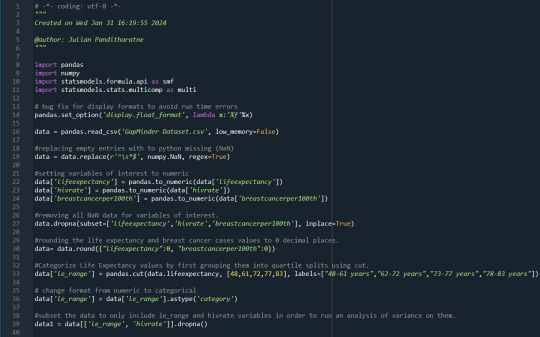

Program Output and Summary:
ANOVA and Post-Hoc ANOVA results for life expectancy and HIV rate
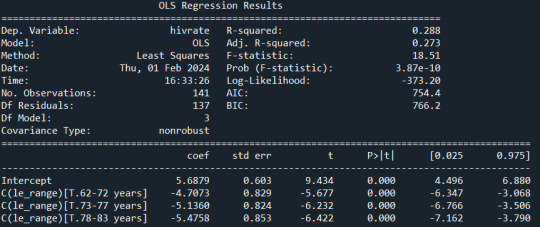


ANOVA revealed that among the countries in the GAPMINDER Dataset, the life expectancy (collapsed into 4 ordered categories, which is the categorical explanatory variable) and the HIV rate (quantitative response variable) were significantly associated, F(3, 137) = 18.51, p = 0.000000000387. Post hoc comparisons of mean HIV rates by pairs of life expectancy categories revealed that countries with a life expectancy within 48-61 years range had a significantly higher average HIV rate compared to the other age ranges (i.e., 62-72, 73-77, 78-83 years). All other comparisons were statistically similar.
ANOVA and Post-Hoc ANOVA results for life expectancy and breast cancer cases
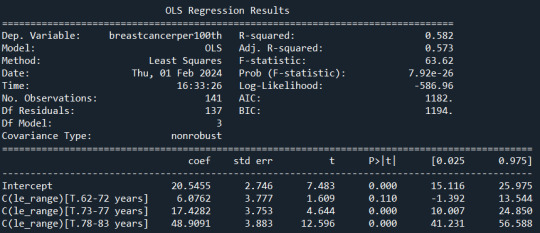
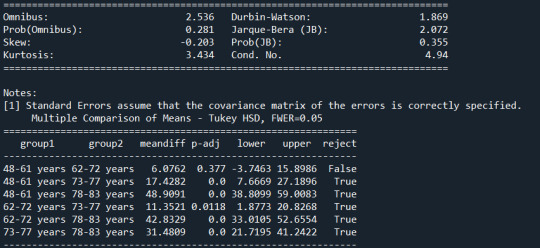
ANOVA revealed that among the countries in the GAPMINDER Dataset, the life expectancy (the categorical explanatory variable) and the breast cancer cases (quantitative response variable) were significantly associated, F(3, 137) = 63.62, p = 0.0000000000000000000000000792. Post hoc comparisons of mean breast cancer cases by pairs of life expectancy categories revealed that countries with life expectancy within 48-61 years range had an average breast cancer cases that was statistically similar to countries with life expectancy within 62-72 year range. All other comparisons were statistically significant. More specifically lower life expectancy year ranges had a significantly higher average breast cancer cases than higher life expectancy year ranges.
0 notes
Text
More Evidence!
As we got Orange back into the mix a few episodes ago I had a theory, and every time they're around I get more convinced that I am absolutely right.
Orange is not in Deerland after the events of Season 1.
From Season 2 Episode 4 as they talk with Mrs. Frye she's clearly discussing Larks and Birdsong and their response is that it sounds bizarre. From the beginning of Season 1 Larks seemed to be a known quantity to all of the Department. The fact that they have no idea what any of the implications of this could be says to me they're in a much earlier point in time
Now as we see them again they mention that they're now sure that there's Department business in Deerland. Sure everything that we've seen of them suggests that they operate on instinct and intuition, but that doesn't sound like they know anything about a Jasmine Control to know she's the same as the missing girl they're pursuing.
In new episode there's a reference to the movements of the thin-head or earworm as looking odd "in the twin moons' light".
Then, after running into the earworm, they want a coffee, an espresso, but cold and nicotine and are unfamiliar with the fact that iced coffees are totally a thing and vapes are a bit of an alien concept to them and Lena, our waitress, still labors under the belief that she can use vapes to actually quit nicotine, all of which tracks with my memories of about a decade ago.
Everything about this episode really seems to confirm that idea concretely, but I bring it up because my theorizing up there is nothing but a foundation for my real speculation. Olivia had always been a part of this group going out to the State Park in Scarlet's memory.
Back in Season 1 when Scarlet first mentioned that she had some kind of history with variance she brings up that she was out with "A close friend, Darryl, and... someone else." First time I heard it I thought she was just unsure of how to describe the 4th member of the party, but the second time I think I thought that she was trying to hide their identity. But after we got into Season 2 I started a relisten, and I don't think that she properly remembered who was out there with her.
Then when Jasmine went on her first Jaunt she went into Scarlet's memory and she *knew* that she saw Scarlet despite never having met her, and then the second person she later confirmed was Violet, then she was convinced that Ivory Torment, the doppleganger, had followed her into the narrative pause of the Jaunt because someone with her face stepped out of the Jeep. We're told this is all impossible, but this is a job where everyone regularly interacts with fictional and semifictional entities. With all else occurring this slipped through the cracks of discussion. (Besides, there was flirting to be done)
When we get Scarlet's view of sitting in this memory, she says it feel like she'd always been friends with Jasmine. Now given the way nostalgia plays high in the powers and effect of Birdsong and the Larks I thought it was just how everything plays with your memory, but what if she's just accessing memories that'd been fucked with before pushing them aside.
As Jasmine got trapped and we ended Season 1 I wondered how she was going to act in the past now, but we discovered she's actually in a memory, but not like on a jaunt where she's watching from afar and not interacting. With that revelation I started racing my mind to figure out how the memory, the dream, was going to explain her introduction to this group
Later, again in Estranged from Grace, when talking with the garage band the response is not to say that she's so much older, a "decrepit twenty something" in the words of Nadia. They discuss how she was a prep and "in different social circles". This implies that she's somehow the same rough age cohort as the kids. Same as Nadia and Alex.
Almost identically, Lena has her own thoughts about her. Lena's been putting together the breadcrumbs of variance that get things grabbed out at the State Park. She notes that the "gay girl" was one who went totally missing. So did the teen from Guatemala, but I don't think we've run into them yet.
I think all of this means we'll get to the end of the season where our Trio and Orange will meet up. Jasmine/Olivia will find a way to conceal the exact nature of how much interaction Alex and Nadia had with all of it, and so that only she gets the full mind wipe, while Alexa and Nadia are just made to forget how they knew her because she works out that's how it always had happened. Orange clearly didn't report much of it, though, but Orange doesn't seem one who loves paperwork and reporting. We know this because Olivia is grabbed as an example of someone with zero exposure to Variance. Which, considering both how Scarlet mentioned that queerness is its own form of Variance and Jasmine's line, "She's bi, I'm bi, everyone is bi!", suggests that even more of her life has been concealed from Yellow's plan. The question is whether Orange intended on messing with the plan or if the universe just enjoys messing with her.
#department of variance#speculation#spoilers#cannabis inspired thoughts#with my corkboard#somewhere ohio#From the analysis of Indigo Datum#horror podcast
0 notes
Text
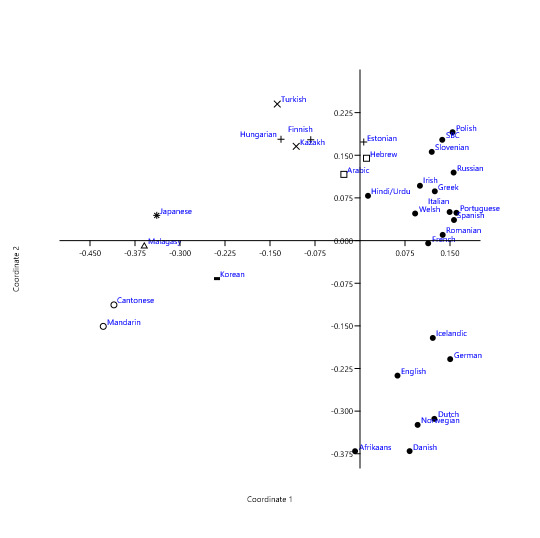
i love getting to make leetol pictures for my dissertation
#it is not Entirely clear to me what this leetol picture actually means#the principle coordinate analysis produced. 32 coordinates. of which these are the two which account for the most variance#i am not really sure what if they can be said to correlate to anything in the structure of these languages#the pcoa having been performed upon a distance matrix derived from a set of syntactic parameters#it sorta looks like coordinate 2 has some association with 'analyticity'?#coordinate 1 looks broadly like. indo-europeanness. dunno what that specifically could be.#idk it might all be Nothing and my supervisor might tell me to take it out#dissertationposting
1 note
·
View note
Text
I was asked today what kind of person I am. Not really understanding the question, I responded with "the breathing kind...I guess?" Which got some chuckles.
Later, while taking my shower, I thought about the many different things that tend to pop up randomly. You know...shower thoughts and all. Anyway, I remembered that I need to get an oil change, probably get new tires, and definitely need to get new brake pads. Then I wondered how many miles I had driven in the last seven or eight years, and then I wanted to know what that meant in terms of traveling around the globe.
So, to answer the question "what kind of person are you," the answer is now "the kind that takes a dry erase marker into the shower to try and solve meaningless math problems."
The answer is 17 and some change. I've driven so much over the last seven or eight years to have driven along the equator a little more than 17 times, or approximately 289 full days in a vehicle.
#coincidentally#this is how I got through grad level behavioral statistics#I once tried to an ANOVA (analysis of variance) in my shower using a random set of data#it didn't go well#not at first anyway#doodling is fun too#nerd alert
0 notes
Text
Study Results (1/??)
I'll post some of the results now! Firstly, I'll write about how I processed the data for those interested in details. (Please inform me if you see anything wrong or want to suggest a different method. I'm just an average person with an undergrad degree...)
If you just want to see the analysis, skip the data cleaning and test assumptions part! As a disclaimer, I don't know if this is all for now or if I can bring myself to work more on it soon 😭
Special thanks to @xavieslittlestar and @m00nchildwrites for sharing this on bluesky and twitter
Data Cleaning
I realized that some of you guys didn't do the test and wrote the numbers by yourself 😊 And it took me hours to clean the data
As expected, there were some typos, and I corrected them before deciding which participants to exclude. For instance, some wrote 29/20, and since the sum of the subfactor scores is equal to your main factor score, I was able to confirm that it should be 19/20 by doing main_factor_score—other_subfactors = target_subfactor.
After dealing with typos, all participants who entered random values like 0000 and values that didn't align with the main factor scores were excluded.
In the end, the sample size was reduced from ~2600 to 1929.
Test Assumptions
The normality and homogeneity of variance were checked. Most of them fulfilled the homogeneity of variance(Levene's Test), but normality was problematic. I assessed normality based on Kolmogorov-Smirnov(KS), kurtosis, skewness, and Q-Q plot. There were some outliers, but most of them were a natural part of the data, so I didn't change anything about them. Although KS values were lower than .05 , I assumed normality if kurtosis and skewness seemed average (-2 to +2 for kurtosis, -1 to +1 for skewness). For others, I tried trimming, LOG, SQRT, Z, and LN transformations, but still couldn't normalize... Winsorizing would probably work, but there are too many participants(yes, I'm lazy). So, I'm gonna be relatively liberal about normality.
Results
Please note that all of them have small effect sizes (0.2 Cohen's d or 0.1 η2). So regardless of the p values, the actual association between your personality based on the big five and character choices in lads might be small in degree. Also, this is an observational study, which means you shouldn't try to infer a causation or a strict relation (so use it just for your enjoyment, not for fandom chaos~). But I'll put my personal comment under them because I need to enjoy myself too lol
Also, I realised that some of those are changing or disappearing when I compare poc(people of color) and non-poc within themselves. Therefore, the effects might be moderated/mediated by cultural differences as well.
===Trust====
Sylus mains had the lowest mean score in terms of trust(M=11.2, SD=3.42). Yet, they significantly differed only from Xavier mains who had the highest mean(M=12.1, SD=3.28).

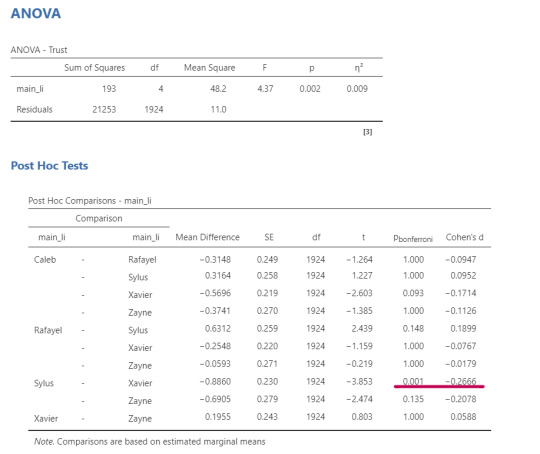
Personal comment: I don't know what to make of it. But let me put those here as well.
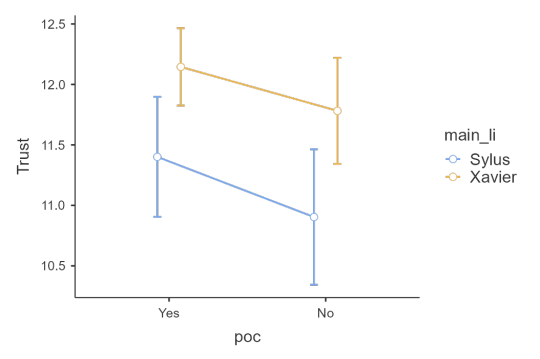

==Conscientiousness and Agreeableness==
I'll write this together because I have a theory about these results.
Caleb mains' scores were the lowest in terms of conscientiousness (M=74.3, SD=13.7) and agreeableness(M=84.4, SD=13.8). For conscientiousness, they significantly differed from Zayne and Sylus mains. And for agreeableness, they significantly differed from Zayne and Xavier mains. [Agreeableness showed unequal variances, so I used Kruskall-Wallis test]

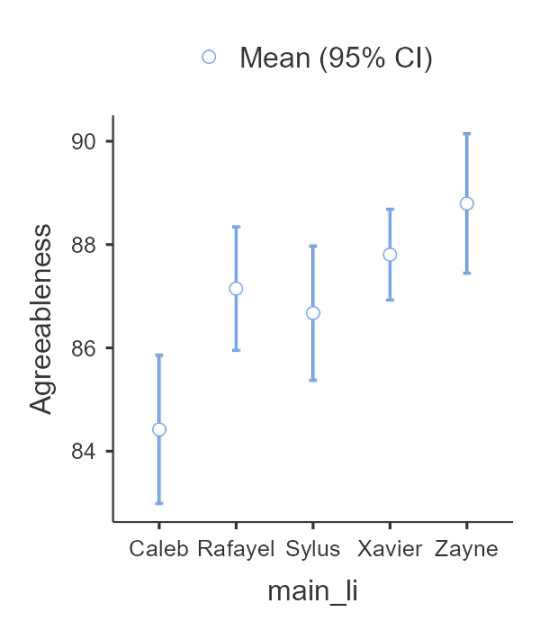
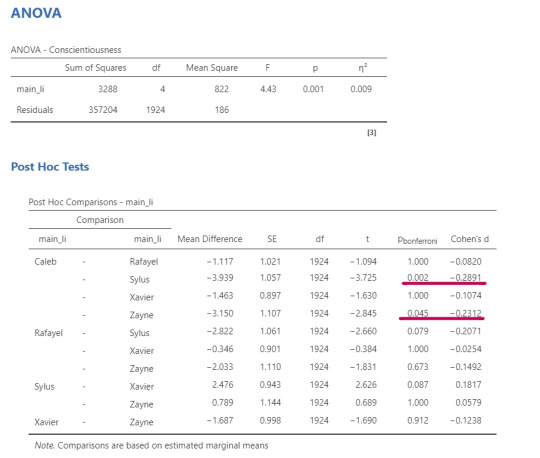
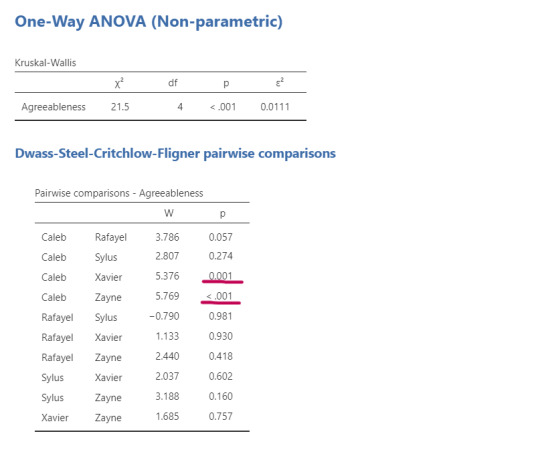
Personal comment: Honestly, I'm surprised. (Caleb and his girlies not beating red flag/villain allegations)
If anything, I would expect Sylus mains to have lower agreeableness and conscientiousness (first impressions don't disappear).
Then I thought, what if it's related to Caleb being MC's adopted brother? Listen before shooting me. To feel at ease with this setting, you should have higher (but healthy) dissociative tendencies to detach yourself from its real-life associations. And guess what— low agreeableness and low conscientiousness are related to high disassociation [refer to:https://www.sciencedirect.com/science/article/pii/S1130527417300373]. Secondly, having a lower need to conform(related to agreeableness and conscientiousness) with others might be making it easier for some people to choose Caleb as their main love interest.
(But as I said, these results are liable to change. For instance, for the non-poc sample the lowest mean value of conscientiousness belongs to Rafayel mains)
===Emotionality===
Caleb(M=14.7, SD=3.49) mains had the lowest emotionality score, and the difference between them and Zayne(M=15.6, SD=3.04), Rafayel(M=15.5, SD=3.11), and Sylus(M=15.5, SD=3.33) mains was significant
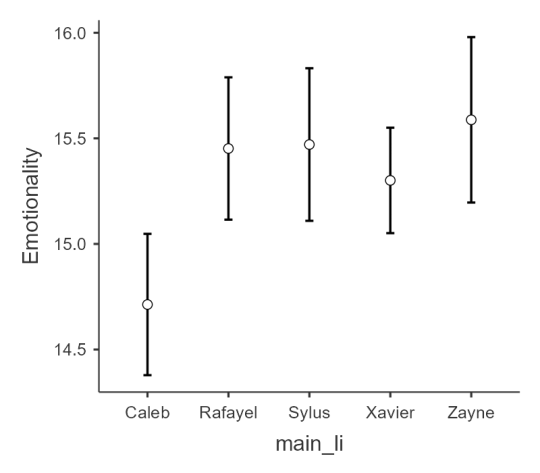
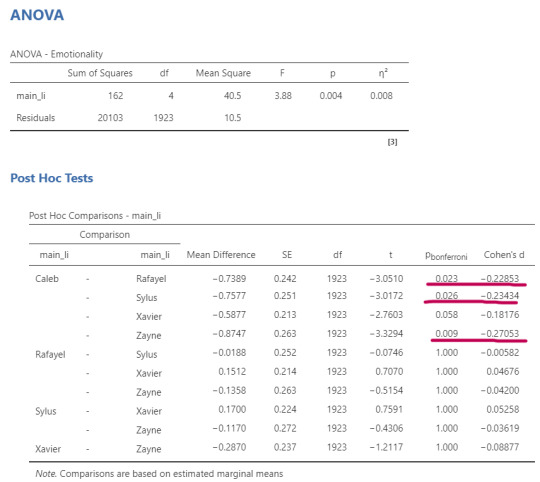
Personal comment:......Babes lolololol. Is Caleb's robot alter taking over his mains?? Did they get a Toring chip as well? It's so funny omg
===Self-Discipline===
Rafayel(M=10.1, SD=2.96) and Caleb(M=10.1, SD=2.97) mains had similarly low scores of self-discipline, and they differed from Zayne(M=10.8, SD=2.87) and Sylus(M=10.8, SD=2.79) significantly.

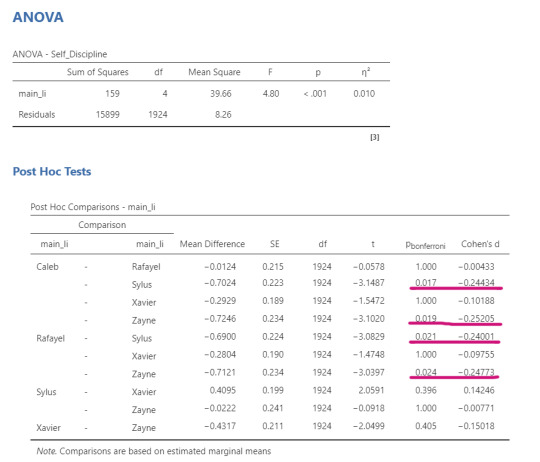
Personal comment: As a Rafayel main, I can confirm this.
=Second Love Interest=
Most of Zayne mains chose Sylus as their second love interest. The other most preferred second love interest was Caleb, but since this test was done just before Caleb's new myth, the results might be affected by our excitement for it. Also, Zayne mains showed low preference for Rafayel.
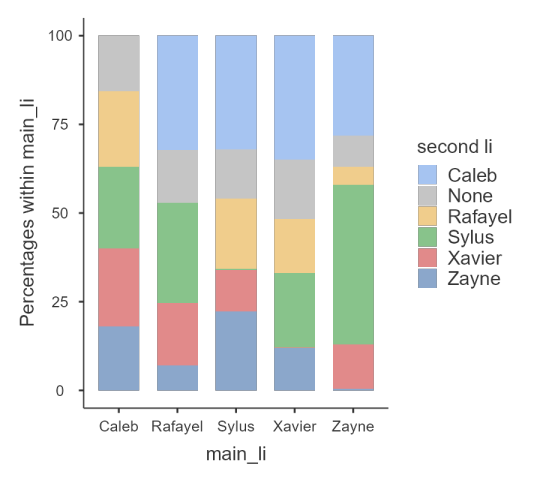
A note about less significant/non-significant observations:
As a whole, we have low extraversion and average conscientiousness, as well as high openness to experience, neuroticism, and agreeableness
For subcategories, we have the highest mean for imagination and the lowest mean for gregariousness. (perfect combination to date fictional men)
Sylus and Zayne mains had similar mean scores in many main factors and subfactors of the Big Five test. Likewise, Rafayel and Caleb mains' scores were close to each other, and they contrasted with Sylus and Zayne(not always significantly tho). Xavier mains generally had balanced scores.
None of the groups differed significantly in terms of openness to experience, neuroticism, extroversion, and these factors' subcategories.
To check if the data gives standard results, I checked socioeconomic status(SES) and its relation to neuroticism since previous studies indicate higher neuroticism for low SES groups, and it was the same for this dataset as well. Anxiety, depression, and neuroticism showed a slightly decreasing trend as the SES increased.
Some studies suggest that people of color have lower trust scores, but in this study, poc had higher trust than non-poc. However, it might be due to the differences in exposure to discrimination between poc who live in the US and those who are natives of other countries.
Tag list: @dadddybangtan @gingers-random-junk @cloudyasteria @eoe-1379 @kwtdrn @punksausages @satorusfrontallobesilverhair @xanxann01 @dandellien @auraficial @fictionalmenlover5 @bundle-of-sunlight @starryfilled @cupcakefactory @rayamalaya @mandapanda16 @nouerzzz @jonggunkitten @fckkntired @dreamienebula @tiffyelefano @bbnique @maybeyougotmewrong @starrychxn @situationsheep @maimaily @irlsammy @meowumis @piranha-teeth @svnflowery @soapsoftheworld
#love and deepspace#lads#恋と深空#恋与深空#l&ds#lnds#rafayel love and deepspace#caleb love and deepspace#xavier love and deepspace#sylus love and deepspace#zayne love and deepspace
261 notes
·
View notes
Text

A rambling analysis of Ivan's "Nowhere" (spoilers for up to round 7)
I'll start with my thoughts on the song itself, then break down some of the lyrics.
So, "Nowhere" is quite a bit different from Ivan's other songs, mostly in regards to the melody and his singing. His voice is a lot more... flat, and the pitch and length of the notes vary a lot less. In "Cure" and "Black Sorrow," there's a lot more variance: Ivan's voice goes from soft and low, singing shorter notes, to louder and higher, holding long notes, et cetera.
In Nowhere, the notes are typically shorter, and tend to stay in the same general area on the scale. Ivan's tone stays very consistent; in his other songs, it goes from calm and collected to full of emotion and feelings. He sounds a lot more monotone in Nowhere, and not just because he's singing quietly. He's not entirely apathetic; there's still a lot of emotion in his voice. But it's muted. Numb.
The only line that lacks this somewhat monotone, apathetic tone is "In love with you, when you were mine." This line is EVERYWHERE, and plays in the background of the ENTIRE TRACK.
And all of this kind of makes sense. "Black Sorrow" and "Cure" were both declarations of Ivan's love, and his feelings for Till. They were meant to be heard; they were meant to have an audience in Till. Ivan was projecting his emotions outwards.
"Nowhere" was not meant to be heard by anyone but Ivan himself—not even Till. It represented Ivan's internal thoughts, ones he would never say to anyone else—sort of how like someone might find certain things about a friend or significant other annoying, but choose not to say anything despite thinking it. Ivan is tired, and perhaps even a bit annoyed. He's wondering why Till doesn't return his feelings, and likely, wondering why he himself continues to love Till despite that.
Now, onto the lyrics (English translation b/c my Korean is awful):
That's just the kind of kid he is, so laugh Laugh, because he can't do anything No one cares about someone like him There's nowhere in the world for him to rest
It's been stated (see image below) that Ivan feels like he cannot be loved—that he's undeserving of it, or just doesn't have the qualifications. These lyrics are Ivan speaking about himself. Ivan is unable to get Till to return his feelings ("no one cares about someone like him"), and he is also, ultimately, unable to save Till ("Laugh, because he can't do anything"). To make this second thing worse, it happened not once, but TWICE: first when Ivan couldn't get Till to leave with him, and then when his actions in Round 6 ended up seemingly being for nothing in Round 7.

Another bit of the lyrics is as such:
Worse and worse this painful wound I become more and more numb
Ivan is slowly becoming more and more apathetic, and resigned to his fate, saying that "this always happens to me." Even the song's title is a reference to this: there's nowhere for Ivan to find solace, and all of "this" is going nowhere—"this" being Ivan's relationship with Till. Ivan is resigned to his fate of loving Till—almost certainly more than he loves himself—un"till" the end: until death.
#all this to say i love ivan sm#im just on my knees like#till#till plz#like i cant blame him for not loving someone back but plz surely you guys can make it work right?? right???#like till plz do it for ivan pleasseeeee it's so sad why does alnst have to be so goddamn SAD im sobbing#alien stage#ivan#ivantill#nowhere#alnst#alnst till#alnst ivan#my posts
169 notes
·
View notes
Note
So amid all of the pairing discourse being sent to this blog, one little thing stuck out to me. Someone commented claiming that AkuRoku is one of the most popular pairings on AO3 with some of the largest numbers of fics, but being the statistics nerd I am, and knowing the general trajectory of this fanbase, I decided to run some numbers and put that claim to the test.
(Actually, looking into that got me really curious about the general popularity over time of all the relatively notable pairings in KH, so I think I might eventually make a formal post compiling all my findings once I have a little more time. This is definitely informal, but it’s just an initial impression of my research thus far. Obviously, take this with a grain of salt: fanfic is only one piece of the general popularity puzzle, but it does seem to be generally understood as a decent benchmark for analysis of broader trends within fandoms.)
As a note, I measured fic numbers by date of update from April to April, year to year on AO3, so factors like game release date timing should be taken into account.
To absolutely no one’s surprise, SoRiku is the undisputed king of KH shipping. It’s been going incredibly strong since 02 but even then experienced a massive jump at KH3’s release, number of fics updated in the year multiplying nearly 6x in 2019 from where it had been in 2017. It’s slowly settled down since, but is still holding at well over 300 fics per year, even during this content drought. It’s vastly above everything else in popularity and always has been.
Most pairings have followed a similar pattern since KH3’s release: The entire fandom experienced a general jump in activity and most pairings got a boost from 2018-2020, although some more dramatically than others: Akusai fics (inclusive of fics tagged just leaisa, just akusai, or both, not counting the same fics twice) experienced a more dramatic leap than any other pairing in 2019, going from just 40 in 2017, to 183 the following year, to 350 in 2019–an 8x jump in interest. (Wow!)
Like Soriku, most other pairings have generally gone fallow since 2020, as that was the last time we all got any sort of content. (Missing Link when Nomura.)
As far as the stats for Akuroku go… Honestly a bit gobsmacked by the trends in the data. I decided to include both number of fics updated per year on both AO3 and fanfiction.net, as the fandom’s early 2000s heyday can’t really be accounted for on AO3. fanfiction.net’s numbers are a little inflated because I couldn’t honestly be bothered to separate out the infinitesimally small number of non-ship fics in the 2000s and early 2010s from the overwhelmingly large proportion of ship fics there, but if you compare how many fics that pairing used to get in its heyday from 2006-2011, it used to average out at roughly 1000 fics a year.
From 2012 on, the drop in popularity is precipitous—on both fanfiction.net and AO3. it had less than half the fics in 2012 on fanfiction.net than it did in 2010, and it’s continued to exponentially decline there since. For example, there were no AkuRoku ships updated on fanfiction.net last year, and there were only 2 updated the year before. (Noting that fandoms at large did begin to increasingly migrate away from fanfiction.net after 2012, which also explains similar but less extreme declines in otherwise healthy ships like SoRiku on that website).
It fares a little better on AO3, although it’s been eclipsed in popularity by ships that were once drastically less popular than it involving the same characters at several points—Leaisa/Akusai for example consistently had hundreds more fics than it from around 2018-2020, an impressive feat considering that ship basically didn’t exist prior to 2013~2014, although it’s gone quieter since.
AkuRoku has remained pretty much consistent at roughly 150~200 fics per year on AO3 since 2012 (a couple years have had roughly a 10~20 variance above or below that, no significant jumps either way, though it did roughly halve from a high year in 2020 to a low year in 2021) which leads me to believe that it’s… probably more off in its own world separate from what the rest of the fandom is doing than other ship communities? It doesn’t follow the same trends as ships that are more closely following the story developments in canon do.
It’s kind of surprising to see it be that much of a general drop, though. I knew it was less popular than it once was, but I didn’t realize just how much less popular it really is. 150~200 fics updated a year sounds like a lot, but if you compare it to how absurdly ubiquitous it used to be, it’s a shadow of its former self. Unless KH4 has a bunch of interactions with them and them alone, going by the trends and general attitude of the fandom, I think it’ll probably just continue to slowly lose momentum. It still has a lot of diehards, but it would appear that the majority compared to that of 15-20 years ago have jumped ship, so to speak. I have a feeling that if Roxas ever gains any significant peer relationships with different male characters in the future, it’ll likely be another nail in the coffin for it as enthusiasm for a gay Roxas ship bleeds elsewhere.
So, uh, basically… everyone who’s freaking out about it, chill? It’s probably just going to continue slowly petering out on its own eventually as the next games move away from the characterization that initially made it popular, whether anyone wants it to or not. That’s what fic trends would appear to indicate, at any rate.
Side note: out of all the pairings I’ve analyzed popularity over time for thus far, I’m surprisingly impressed by Naminé/Xion. I thought it was way more of a rarepair than it actually is. It’s not going anywhere crazy like Soriku, but it’s actually rather consistent with other moderately popular kid pairs like Roxas/Xion on AO3, and saw a jump in numbers above Roxas/Naminé of all things from 2019-2020, which I would never have anticipated. Let’s go lesbians! I guess KH3 really did change things up.
~~~
#confession of the heart#kh#kingdom hearts#anon i applaud you for running these numbers thank you for this. this was a fascinating read
59 notes
·
View notes
Note
*insert michael jackson gif*
Let it go with the excuses already, today was on him he couldn't even beat his teammate today how you people expect him to fight max?he will put it in the wall in the last lap, oh wait it already happened, my bad
also max recommended devries lol let's not take those guys words , charles is currently fighting fraud allegations, unless his 2019 or 2022 start is coming it's only going downhill
Okay, fine, I'll bite. Let's compare Charles's and Carlos's perfomances in order to try and determine with as little bias as possible.
In order to constrain our parameters of our investigation to their current abilities as drivers, let's take the our period of investigation to be the whole of the 2023 season, plus the first three races of the 2024 season. We'll exclude the following races for Carlos due to circumstances beyond his control: Qatar 2023 (fuel leak leading to DNS), Las Vegas 2023 (10 place grid penalty due to track not being properly maintained), Jeddah 2024 (appendicitis). Likewise, we'll exclude the following races for Charles due to circumstances beyond his control: Bahrain 2023 (DNF due to technical issues), Jeddah 2023 (10 place grid penalty due to exceeding allowed quota), COTA 2023 (DSQ), Brazil (DNS due to faulty hydraulics).
There are cases to be made for other races for both of them, but these are races where they were either involved in a collision leading to a DNF or where grid penalties apply, so there's argument for driver error there. With regard to grid penalties, we're going to go by the final decisions made by the stewards regardless of whether the penalties were appealed or not. Races where they suffered technical issues in race but they still finished are not counted, as it shows a driver's ability to handle an unpredictable car.
Before we discount the races listed above entirely, let's have a look at where the driver who didn't have difficulties finished.


So we're discarding pretty much the same number of points between them, so I feel happy discarding the following 7 races entirely from this analysis: Bahrain 2023, Jeddah 2023, Qatar 2023, COTA 2023, Brazil 2023, Las Vegas 2024, Jeddah 2024. Furthermore, in Las Vegas, Carlos finished 6th and in Jeddah, Charles finished 7th. This brings their points total across the discarded races to 46 for Carlos, 45 for Charles. However, Charles managed to score those points over fewer points-scoring races, and with a higher average finishing position, so for the sake of not convoluting ourselves we'll call it even and commit to just examining the points and stats of the remaining races not excluded from our investigation. The table below shows those stats. For simplification, sprints are not considered.
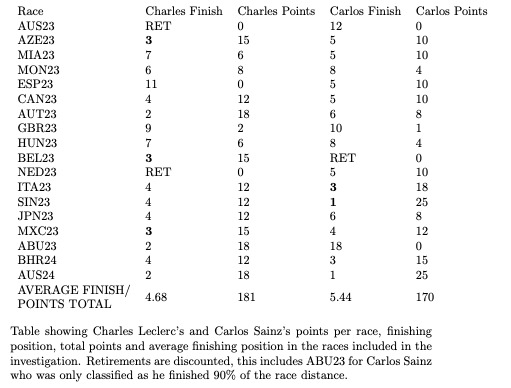
So I think there are a few key things we want to consider: overall performance, reasons for retirements and driver reliability over our chosen time period. So we'll go one by one for each and examine in a little more depth.
For overall performance, it's easiest to see in a quick head to head. Carlos wins in race wins, Charles wins in poles, they tie in number of retirements (although Carlos was classified in ABU23 due to finishing 90% of the race distance), Charles wins in higher average finishing position, Charles wins in higher points total.
Next, we move on to reasons for retirement. Charles retired twice, once upon collision with Lance in Australia 23, and once in Zandvoort due to a damaged floor. Carlos retired once in Belgium 23 due to a collision with Oscar Piastri and once in Abu Dhabi 23 due to being lapped and running last without pitting.
For driver reliability, I want to consider the variance in Charles and Carlos's race finishes for reliability. A quick recap for the non-STEM people who may be reading this: the variance measures the spread of numbers in a dataset, and how far away they are from the dataset's mean. Thus, a smaller variance indicates less spread in positions that a driver has finished in, in turn indicating higher reliability. Charles has a variance of 6.46, Carlos has a variance of 8.25. It is therefore possible to conclude that Charles is the more reliable driver of the two. While on the subject of reliability, it is also worth noting that Charles has not dropped outside the top 5 since Monza last year.
So overall, anon, I'm afraid I have to reject your notion that Charles is washed or even approaching becoming washed. The data show otherwise. The only category where Carlos is superior to Charles in our time frame is race wins, race wins where Charles deliberately adhered to Ferrari strategy in order to help Carlos, and Max Verstappen was out of commission for the win for one reason or another. Carlos wins in luck, but for driver reliability, points scored, finishing position, Charles is the clear winner and the numbers show it.
238 notes
·
View notes
Text
Methods: We performed a single-blind, randomized human experiment evaluating the effectiveness of five different regimens for the treatment of topical facial OC exposure. Forty-nine volunteer, adult law enforcement trainees were exposed to OC during a routine training exercise and were randomized to one of five treatment groups (aluminum hydroxide-magnesium hydroxide [Maalox], 2% lidocaine gel, baby shampoo, milk, or water). After initial self-decontamination with water, subjects rated their pain using a 10-cm visual analog scale (VAS) and then every 10 minutes, for a total of 60 minutes. Subjects were blinded to previous VAS recordings. A two-factor analysis of variance (ANOVA) (treatment, time) with repeated measures on one factor (time) was performed using a 1.3-cm difference as clinically significant. Results: Forty-four men and five women, with an average age of 24 years, participated in the study. There was a significant difference in pain with respect to time (p < 0.001), but no significant interaction between time and treatment (p > 0.05). There was no significant difference in pain between treatment groups (p > 0.05).
eliza comments: this supports the observation that pain-inducing chemical weapon response is primarily time- and somatically-mediated. eg, none of this stuff actually "works" and any effects are related to time making the chemicals degrade. observations that "i used milk and it helped" are a false observation based on the fact that sitting there and waiting for the chemicals to wear off was working anyway, so putting milk on your skin/eyes in the meantime was assumed to have "worked" when it wasn't actually doing anything (other than the skin reaction to cool liquid being felt as "soothing" superficially).
the action of being treated by friendly medics will always help with injury regardless of the injury, its one of the cornerstones of medicine. it's very important for street medics to present a caring, confident, and gentle attitude towards injured people. street medics aren't medical doctors (except when they are, i know dozens of actual EMTs and MDs and RNs who go to protests specifically to provide medical care) but the principles are the same
i'm still looking for the paper i found years ago about buffered saline. the study above notably does not try saline as a treatment.
#riot control agents#protests#protesting#tear gas#cs gas#pepper spray#free palestine#treating tear gas
159 notes
·
View notes
Text
Also preserved in our archive
By Dr. Sushama R. Chaphalkar, PhD.
In a recent research paper posted to the bioRxiv preprint* server, researchers in the United States investigated the potential effect of severe acute respiratory syndrome coronavirus 2 (SARS-CoV-2) infection on cholesterol metabolism, focusing on the role of the viral protein open reading frame 3a (ORF3a).
They found that SARS-CoV-2 causes cholesterol sequestration in lysosomes via the ORF3a protein, which disrupts protein trafficking and reduces the levels of bis(monoacylglycero)phosphate (BMP) in the cell, enhancing viral survival.
Background Coronavirus disease 2019 (COVID-19), caused by SARS-CoV-2, disrupts lipid metabolism, particularly cholesterol homeostasis, which can persist during and after infection. This is linked to disease severity and long-term complications like dyslipidemia and cardiovascular diseases.
Cholesterol is crucial for cellular function and is primarily transported through lysosomes, where proteins like Niemann-Pick C1 and C2 (NPC1 and NPC2) facilitate its release. SARS-CoV-2 may exploit plasma membrane cholesterol to enhance infectivity.
Disruptions in the lysosomal cholesterol pathway can cause cholesterol buildup, impairing cellular functions, and viruses like Ebola are known to hijack this mechanism. Notably, BMP plays a dual role: it aids in cholesterol transport and contributes to viral infection by promoting viral fusion with lysosomal membranes.
In the present study, researchers investigated the potential impact of SARS-CoV-2 infection on cholesterol transport in cells, focusing on the role of the viral protein ORF3a.
About the Study A variety of experimental techniques were employed, including culturing A549, HeLa, and Vero E6 cells, followed by SARS-CoV-2 infection at different multiplicities of infection. SARS-CoV-2 ORF3a-VPS39 interaction was studied using mutations at key residues (notably W193 and Y184, which were identified as critical for this interaction). Immunofluorescence, filipin staining, and confocal microscopy were used to assess cholesterol localization and vesicular dynamics, while high-content imaging quantified cell-specific responses.
Cholesterol levels were measured using gas chromatography-mass spectrometry (GC-MS), and lipid species were analyzed through shotgun lipidomics. For further protein analysis, western blotting was performed to detect secreted NPC2 and cathepsin D, along with cell lysates. Data were analyzed using ImageJ and Prism 9, and statistical significance was determined by t-tests or analysis of variance.
Results and Discussion SARS-CoV-2 infection was found to increase filipin-positive puncta in lysosomes of A549-hACE2 and Vero E6 cells, indicating altered cholesterol distribution, especially in lysosomes, without affecting total cholesterol levels. Among the 28 viral proteins tested, ORF3a showed the strongest increase in filipin puncta, suggesting significant lysosomal cholesterol sequestration.
Notably, SARS-CoV-2 ORF3a localized to lysosomes and caused them to swell, whereas SARS-CoV ORF3a did not induce such effects, highlighting a distinct pathogenic strategy unique to SARS-CoV-2.
ORF3a was found to interact with VPS39, a key component of the HOPS complex involved in cholesterol egress from lysosomes. Key residues W193 and Y184 were shown to form a hydrophobic binding interface critical for this interaction, distinguishing SARS-CoV-2 ORF3a from its SARS-CoV counterpart. Mutations at W193 and Y184 disrupted this interaction, while S171 and H182 had no significant effect.
SARS-CoV-2 ORF3a expression was shown to cause cholesterol accumulation in lysosomes, which was reduced by the W193A mutation. It also led to the mislocalization of NPC2 and increased its secretion, indicating disrupted NPC2 trafficking, likely due to interference with TGN-to-endosome transport. Additionally, BMP levels were significantly reduced in infected cells, which likely exacerbates lysosomal cholesterol sequestration.
In SARS-CoV-2-infected Vero E6 cells, BMP levels were found to decrease at 12 hours post-infection, coinciding with increased cholesterol at 18 hours. In HeLa-Flp-In cells, SARS-CoV-2 ORF3a was found to reduce BMP levels by 20%, with partial rescue in the W193A mutant. Lipidomics confirmed this reduction, correlating BMP loss with cholesterol accumulation and suggesting BMP reduction may contribute to cholesterol sequestration.
SARS-CoV-2 may reduce plasma membrane cholesterol to limit secondary infections, as shown by decreased SARS-CoV-2 infection in NPC1 inhibitor-treated cells. This supports the hypothesis that the virus manipulates cholesterol distribution to optimize replication conditions. Interestingly, the virus also appears to reduce its own infectivity within a single cell, suggesting a self-regulating mechanism to prevent viral overload and ensure broader host-level spread.
Conclusion In conclusion, a novel mechanism by which SARS-CoV-2 disrupts host cell lipid metabolism, specifically through cholesterol sequestration in lysosomes, has been elucidated. By uncovering the specific interaction between the viral protein ORF3a and host protein VPS39, the study highlights a critical role of lysosomal cholesterol trafficking disruption in SARS-CoV-2 pathogenesis.
This discovery opens potential therapeutic avenues to target lipid dysregulation in COVID-19, which could help mitigate both the disease's immediate and long-term metabolic consequences, including dyslipidemia and cardiovascular complications.
Journal reference: Preliminary scientific report. Manipulation of Host Cholesterol by SARS-CoV-2. Aliza Doyle et al., bioRxiv, 2024.11.13.623299 (2024), DOI: 10.1101/2024.11.13.623299,
Study Link: www.biorxiv.org/content/10.1101/2024.11.13.623299v1
#mask up#public health#wear a mask#pandemic#covid#wear a respirator#covid 19#still coviding#coronavirus#sars cov 2
66 notes
·
View notes
Text
A thing I've noticed, about fan-analyses of fiction: often, once a given reader gets caught up on a given work and starts talking with the rest of the fandom, their readings and theories become more similar to those of the rest of the fandom. This tends, on average, to make most people's readings and theories more correct—people are able to absorb right-sounding-sounding popular analyses while rejecting the wrong-sounding ones, at least directionally even if not in all particulars—but it also tends to make them more homogeneous. Someone who's internalized more of the fandom zeitgeist is less likely to come up with a wildly-novel analysis whose premises contradict those of the fandom zeitgeist.
As such, first-time readers—particularly first-time readers doing detailed close readings, and even-more-particularly those who write down said readings as they go in order to avoid forgetting them after their eventual merge with the broader fandom—serve a valuable role in fandom ecosystems as a source of diversity and novelty of ideas. In the traditional manner of high-variance strategies, many of them will come up with bad ideas, worse than those the fandom has mostly settled on; but they'll come up with different ones, and some are likely to be new-and-good in ways that the main body of fandom would have had trouble replicating.
This is among the many reasons why it's good, when someone is liveblogging a work, to be careful about avoiding leaking any spoilers to them. It's not just valuable to that person's reading experience and (thereby) to the reading experiences of the people reading the liveblog, but also to the broader fandom which benefits from liveblogs as a source of novel analyses which would be harder for non-first-time readers to generate. And this is also among the many reasons why it's good to do liveblogs, when one happens to be in a position where doing so is logistically practical.
20 notes
·
View notes